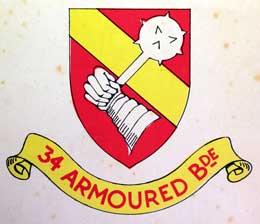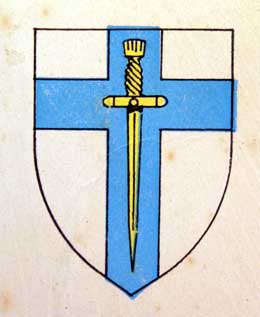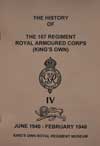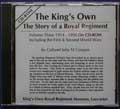 |
King's Own Royal Regiment Museum Lancaster |
|||||
|
HOME Museum & Collections Soldiers of the Regiment Sales Donations Events Contact Us REGIMENTAL HISTORY 17th Century 18th Century 19th Century 20th Century First World War Second World War Actions & Movements Battle Honours FAMILY HISTORY Resources Further Reading PHOTO GALLERY ENQUIRIES FURTHER READING LINKS
|
Regimental History - 20th Century 107th Regiment, Royal Armoured Corps, The King's Own Following their withdrawal from France in May 1940 the 5th Battalion King's Own switched to a defensive role in anticipation of a German invasion whilst the newly created 10th Battalion undertook a similar duty on the Northumberland coast. In late 1941 these battalions, were converted to tanks and became part of the Royal Armoured Corps and eventually were merged and became the 107th Regiment Royal Armoured Corps, (The King's Own). From February 1942 the 107th Regiment was based at Keighley, with training also taking place at nearby Otley. In August 1942 the Regiment moved to Leyburn, where they remained until April 1943, except for a period between 6th and 10th October when they moved to the Bedford and Bamburgh area in Northumberland. In May 1943 they were back in Otley, until the end of October when they moved to Boston, and it was there in December 1943 that the 107th was disbanded and its personnel dispersed to other units. In order to maintain the link with the King's Own Royal Regiment, the 151st Regiment, Royal Armoured Corps, was then re-titled to the 107th Regiment, Royal Armoured Corps (The King's Own), and thus for the remainder of the war the served with that title and wearing the King's Own cap badge. In January 1944 the new 107th Regiment was based at Folkestone, with some elements at Southwick, near Brighton. On 16th February 1944 the Regiment moved to Goodnestone, near Folkestone. On 19th March 1944 the Regiment was in the north of England at Warcop ranges, returning to Goodnestone in April 1944. Later that month the Regiment moved to the Aldershot area and was based at Lindford, where they remained until June 1944, on the 22nd June 1944 they moved to the Portsmouth Area, moving to Gosport on 3rd July 1944, from where they left for Normandy. The men of the 107th were constantly training for the planned offensive in France, and in the early part of 1944 their Churchill tanks were supplemented by a number of 'Stuarts', a light American tank, as replacements for the bren-gun carriers in the reconnaissance platoons. In May, waterproofing of the vehicles was carried out in preparation for their movement to France but it was not until 20th June that the vehicles were moved into marshalling areas to go across the Channel. The allied advance following the landings in Normandy on 'D Day,' 6th June, had fallen behind schedule, and this factor combined with bad weather resulted in the arrival of the 107th in Normandy as part of the 34th Independent Armoured Brigade being delayed until 3rd July. Names of the Churchill Tanks of the 107th Regiment, RAC. On 25th July the Americans broke from their beach-head and the major advance across France got underway. The 107th were involved in the Battle of Caen, at Hill 112 near Esquay, south west of the City and following heavy fighting at Grimbosq and Brieux on the 7th and 8th August crossed the River Orne and concentrated to the west of Falaise for reorganisation. An entire squadron from the 153rd Regiment RAC joined the 107th as the former was disbanded. From Falaise the Regiment crossed the River Seine and moved to Le Havre where they assisted the general assault and liberation of the Port. The Regiment was out of action whilst the airborne landing took place at Arnhem, but as the army group advance through Belgium and Holland the 107th had the vital roll of protecting the over-stretched supply corridor, and moved to Eindhoven to support the 53rd (Welsh) Division on the west of the corridor. On 20th October operations against the port of Antwerp began and in nine days of heavy fighting 19 tanks were put out of action. Weather conditions began to slow the Allied advance, but the end of the war was in sight and once Antwerp had fallen the port could be used to supply the Allied advance which greatly improved the situation. A combination of severe weather and mud caused the suspension of activities during December 1944 and January 1945 but on 8th February, after five hours of artillery bombardment and by now under the command of the 51st Highland Division, the regiment took part in the attack on the Siegfried Line in the Reichswald area. After three weeks of heavy fighting the area was cleared and the Regiment stood down and moved back into Holland for a fortnights rest. 34 Tank Brigade was placed in Second Army Reserve for the Rhine Crossing on 24th March, but was not required and the 107th did not cross the Rhine until 7th April and, until the war ended on 8th May, took part in internal security duties at Bocholt and, later, Munster. 30th June 1944 107th Regiment was loaded on to landing craft. 1st - 2nd July 1944 107th Regiment disembarked on the beach at Courseulles 3rd July 1944 107th Regiment concentrated at Cully. 15th July 1944 The first action of the 107th Regiment. In support of an infantry unit of the 15th (Scottish) Division at Hill 112 with the aim of taking the villages of Bon Repos and Esquay. August 1944 107th Regiment concentrated to the west of Falaise for re-organisation. September 1944 The 153rd Regiment Royal Armoured Corps of the 34th Tank Brigade is disbanded and an entire squadron joined the 107th Regiment as C Squadron. 11th September 1944 107th Regiment takes part in the attack on Le Havre. 20th October 1944 Attack on Wuestwezel. 26th - 28th October 1944 107th Regiment at Esschen, launches through Nispen to Brembosch, where fierce opposition was found. Advanced up Wouwsche Hill to Oostlaar and the Regiment moved into harbour at Wouw 29th October 1944 to 3rd December 1944 107th Regiment at Wouw, Breda, Oudenbosch and Budel. 3rd December 1944 107th Regiment attack Blerick, a suburb of Venlo west of Maas. The Regiment moved to join the Brigade at Braunssum, under 43rd Division. They took part in the attack on the Siegfried Line defences, in the region of Sittard on the German-Dutch frontier. The attack was postponed owing to ground conditions. Owing to a German break through in the Ardennes the Regiment eventually moved to Tongres. At the end of December the Regiment moved to positions on the east of the River Meuse in the area of Celles, the village which marked the deepest penetration of the enemy's counter offensive in the Ardennes. January 1945 107th Regiment moved back to Holland, first to Namur and then Eindhoven and onto the Northern end of the Siegfried line on the Eindhoven-S'Hertogenbosh Road. 6th February 1945 107th Regiment concentrated in Reichswald Forest. 8th February - 28th February 1945 Attack begins, through thick mud and thickly sewn mines. Many tanks got bogged down and recovery crews were stretched to the maximum by having to keep tracks from of broken down tanks. When the Mook-Gennen Road was taken the advance was more rapid. The 107th Regiment was present in actions at Gennep, Hekkens, Goch, and along both sides of the river Niers. 19th February - 21st February 1945 Several days were spent mopping up the area, mainly in dealing with pill boxes. March 1945 107th Regiment moved to Holland and remained at Deurne for a fortnight's rest. 24th March 1945 34 Tank Brigade placed in second army reserve for the Rhine Crossing but it was never necessary to use it. 7th April 1945 107th Regiment, less B Squadron, crosses the Rhine, taking over internal security of an area south of Bocholt. 8th May 1945 Victory in Europe Day, the German's had surrendered and the 107th Regiment's actions in Europe were over. 31st May 1945 107th Regiment moved to and concentrated in a large barracks just west of Munster. June 1945 Orders were received to go to the South East Asia Command as a tank battalion. 15th August 1945 The dropping of atomic bombs on Japan caused the sudden collapse of Japan and the planned move to South East Asia Command was cancelled.
Photographs of the 107th and 151st Regiments can be found in the Photo Gallery. Books on the 107th Regiment Royal Armoured Corps
Only a proportion of our collections are on display at anyone time. Certain items are on loan for display in other institutions. An appointment is required to consult any of our collections which are held in store. |




